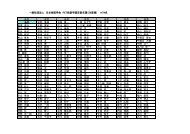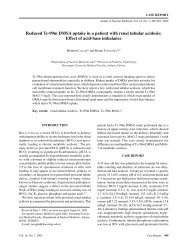Radiopharmaceutical management of 90Y/111In labeled antibodies ...
Radiopharmaceutical management of 90Y/111In labeled antibodies ...
Radiopharmaceutical management of 90Y/111In labeled antibodies ...
Create successful ePaper yourself
Turn your PDF publications into a flip-book with our unique Google optimized e-Paper software.
ate in a Cerenkov liquid scintillation system. By contrast,<br />
90 Y-induced radiation does interfere with 111 In counting<br />
in a γ-counter. By means <strong>of</strong> a cross-over table (Sharkey<br />
and coworkers (pers. comm.)), the count rate <strong>of</strong> 111 In can<br />
be corrected for the 90 Y backscatter.<br />
Before the actual administration to a patient, 90 Ypharmaceuticals<br />
are diluted into a large volume (100 ml)<br />
in order to avoid putative radiolysis <strong>of</strong> the protein. Since<br />
infusion <strong>of</strong> 100 ml is time-consuming compared to injection<br />
<strong>of</strong> small volumes, we have developed appropriate<br />
shielding materials in order to protect the assisting personnel<br />
from irradiation.<br />
The objectives <strong>of</strong> this report were to integrate relevant<br />
but scattered knowledge <strong>of</strong> 90 Y <strong>management</strong> with some<br />
newly developed applications and to apply these in the<br />
setting <strong>of</strong> routine production <strong>of</strong> radiopharmaceuticals. As<br />
a result, we have implemented procedures for efficient<br />
shielding during preparation, accurate 90 Y/ 111 In dual isotope<br />
determination for wide ranges <strong>of</strong> radioactivity, and<br />
the safe administration <strong>of</strong> 90 Y/ 111 In-<strong>labeled</strong> radiopharmaceuticals<br />
to patients in large volumes.<br />
MATERIALS AND METHODS<br />
For reasons <strong>of</strong> clarity, we first provide an inventory <strong>of</strong><br />
relevant equipment used for daily routine, and separately,<br />
we specify the adaptations made for the <strong>management</strong> <strong>of</strong><br />
90 Y.<br />
Laboratory equipment for daily routine<br />
Manipulations are performed in a class A laminar flow<br />
cabinet (Clean Air Techniek B.V., Woerden, the Netherlands)<br />
placed in a class D environment. The cabinet was<br />
constructed with 3 mm lead protection in the walls and 6<br />
mm lead in the base (Veenstra Instruments, Joure, the<br />
Netherlands). Front protection consists <strong>of</strong> a 2 cm thick<br />
rolling lead glass window (equivalent to 6 mm lead).<br />
Amounts <strong>of</strong> radioactivity in the range <strong>of</strong> 1 MBq to<br />
50,000 MBq are routinely measured in a VDC-405 radionuclide<br />
dose calibrator (Veenstra Instruments, Joure, the<br />
Netherlands). The predefined isotope-specific calibration<br />
factor for 111 In measurement in the dose calibrator was<br />
found to be appropriate using a certified 150 MBq 111 InCl3<br />
source obtained from Tyco Healthcare, Mallinckrodt<br />
Medical, Petten, the Netherlands. Amounts <strong>of</strong> less than 1<br />
MBq are determined in a 5650 AutoGamma counter (γemitting<br />
isotopes) or in a 1600CA liquid scintillation<br />
counter (β-emitting isotopes), both from Packard. Procedures<br />
for the determination <strong>of</strong> count rate efficiencies are<br />
described below. A Rados RDS-110 (Rados Technology<br />
Oy, Turku, Finland) radiation monitor is used to measure<br />
levels <strong>of</strong> radiation. Instruments are maintained and their<br />
performance controlled on a regular basis.<br />
For radiochemical purity control, the preparations under<br />
investigation are spotted on ITLC-SG strips (1 × 6.5<br />
cm, Gelman, Ann Arbor, USA) at a 1 cm mark. The strips<br />
576 Formijn J. van Hemert, Gerrit W. Slo<strong>of</strong>, Kirsten J.M. Schimmel, et al<br />
are then developed in a mobile phase <strong>of</strong> 0.9% NaCl (anti-<br />
CD20) or <strong>of</strong> 10 mmol/l Na2EDTA (anti-CEA) until the<br />
solvent front has reached the 5–6 cm marks. After chromatography,<br />
the labeling efficiencies are determined by<br />
means <strong>of</strong> a miniGITA scanning device controlled by the<br />
GITA v1.64 computer program (Raytest, Hamburg, Germany),<br />
using a high voltage <strong>of</strong> 757 V and a 15–200 keV<br />
energy window.<br />
Additional shielding requirement for 90 Y<br />
For manipulations with 90 Y in the laminar flow cabinet, a<br />
2 cm Perspex shield was applied to the inside <strong>of</strong> the front<br />
protection in order to avoid the generation <strong>of</strong> an excess <strong>of</strong><br />
bremsstrahlung. In case <strong>of</strong> high levels <strong>of</strong> radioactivity,<br />
extra removable L-shaped shields consisting <strong>of</strong> 1 cm<br />
Perspex and 3 mm lead provided additional shielding as<br />
required during incubations. For patient administration <strong>of</strong><br />
90 Y-radiopharmaceuticals by infusion, a 1.6 cm Perspex<br />
container with a Teflon lid was developed to hold the 100<br />
ml infusion bottle. The shielded bottle is hung upside<br />
down in a large-mesh wire-netting. In this position, an<br />
additional lead cover was added to give more shielding<br />
against 111 In irradiation and 90 Y-bremsstrahlung (see Fig.<br />
1).<br />
Calibration and measurement <strong>of</strong> 90 Y radioactivity<br />
Radionuclide dose calibrators are routinely used for preparations<br />
<strong>of</strong> γ-emitting radiopharmaceuticals. They may<br />
also be employed for the quantification <strong>of</strong> nuclides emitting<br />
β-spectra provided that absorption <strong>of</strong> low-energy<br />
electrons and conversion <strong>of</strong> high-energy electrons into γradiation<br />
is taken into account. 13 Vials containing 90 YCl3<br />
in aqueous solution were obtained from either MDS<br />
Nordion (Fleures, Belgium) or from CIS Biointernational<br />
(Gif-sur-Yvette, la France) in amounts certified for calibration<br />
or authorized for preparation. An 1830 MBq<br />
certified 90 Y source was used for checking and adjusting<br />
the predefined isotope-specific calibration factor Y-90v<br />
(the setting for 90 Y in the standard vial) until the read-out<br />
equaled 1830 MBq (corrected for decay). A portion was<br />
then removed from the vial by means <strong>of</strong> a syringe, and the<br />
vial was re-measured in order to determine the amount <strong>of</strong><br />
radioactivity in the syringe. The syringe’s content was<br />
adjusted to a predefined volume and measured in the dose<br />
calibrator in order to adjust the isotope-specific calibration<br />
factor Y-90s (the setting for 90 Y in this particular type<br />
<strong>of</strong> syringe containing the predefined volume). These<br />
manipulations were performed for each vial and each<br />
syringe volume required for the generation <strong>of</strong> a wellcalibrated<br />
patient syringe. These settings were monitored<br />
at each therapy occasion using the calibrated amount <strong>of</strong><br />
90 Y certified for preparation.<br />
For the determination <strong>of</strong> the 90 Y count rate in gamma<br />
and liquid scintillation counters, the content <strong>of</strong> a syringe,<br />
calibrated as described, was transferred quantitatively<br />
(measuring the full and empty syringe) in a preweighed<br />
Annals <strong>of</strong> Nuclear Medicine







